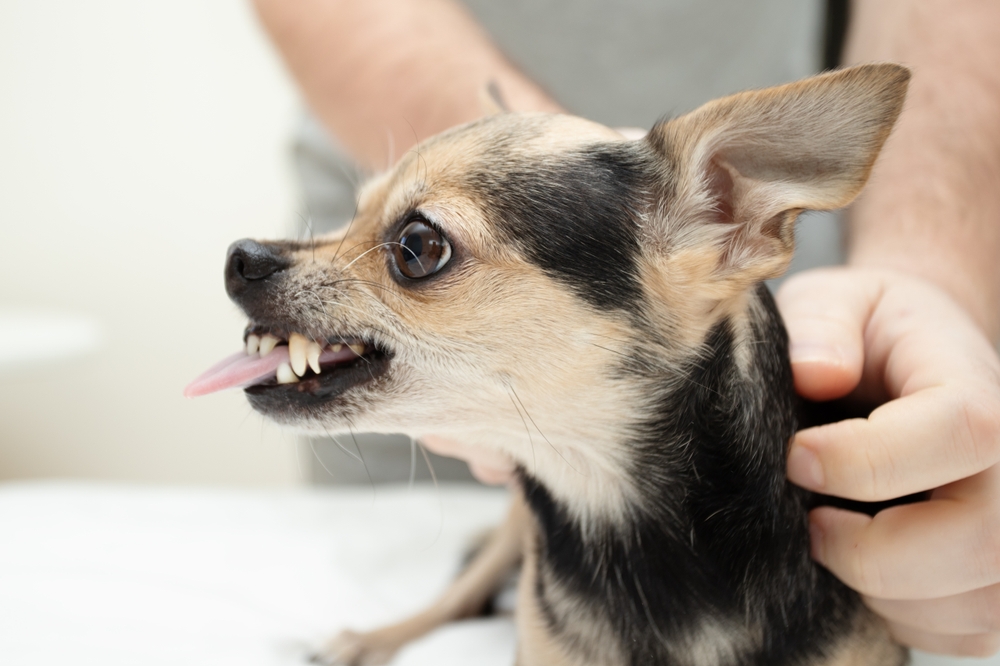We think of dogs as cute, fun, and sometimes cuddly creatures. However, some dogs can develop aggressive behavior, and it is our job as owners to figure out why so the problem can be addressed. One reason for aggression in dogs is pain. This is typically referred to as pain-elicited aggression or pain-related aggression, and it could affect any dog at any time during their life.
Here is what you need to know about pain-elicited aggression in dogs and how to handle it if it happens to your pup.
What Exactly Is Pain-Elicited Aggression in Dogs?
This type of aggression is displayed when a dog is in some kind of pain and wants to keep people—even their owner—from touching or handling them due to their discomfort or even just the fear of increased pain. The source of the pain may not be readily apparent and could come on suddenly, so many owners never expect pain-elicited aggression to take place, and they are caught off-guard. A common reason for pain-elicited aggression is heredity disease, such as hip dysplasia.
Sometimes, the pain is caused by an external and visible injury, in which case, you may be able to determine the type of injury and avoid touching the area. Other times, internal pain is the reason for the aggression. Even if we cannot see an injury, touching the canine might produce a feeling of discomfort because the source of pain is internal. The canine will soon associate a touch with discomfort. Therefore, the dog might growl or snap if someone gets too close or moves an arm toward them—no actual touching is required.

How to Know If Your Dog Is Displaying Pain-Elicited Aggression
Pain-elicited aggression usually comes on suddenly and without warning. One day, your dog might be affectionate and cuddly; the next, they suddenly start shuddering whenever you go near them. If your dog is usually non-aggressive toward people and animals and suddenly becomes aggressive, especially when being touched or handled, chances are that they are in pain.
Pay attention to when your dog starts becoming aggressive. Does it happen only when attention is turned to them and they feel like they will be touched or handled, or is it happening at any time without provocation? This will give you a good idea of what you are dealing with. Schedule an appointment with your veterinarian as soon as possible to rule out pain-elicited aggression.
Pet behaviors can be caused by all kinds of things, but sometimes the source is medical. You can manage veterinary costs with the help of a pet insurance company like Lemonade, which offers adjustable plans and balanced coverage.
What Can Be Done About Pain-Elicited Aggression in Dogs?
The only thing that can be done about pain-elicited aggression in dogs is to identify and treat the source of pain. If it’s obvious, such as a small cut, you can clean and isolate the area with bandages and ensure that you and other household members avoid touching the injured area until it is healed. If the injury is larger or looks too swollen or infected, follow the veterinarian’s instructions about how to care for that particular injury. You may need to put a muzzle or cone on your dog while tending to the injury for your own safety.
If you are unsure what the source of pain is, check with your veterinarian. They will do a physical examination to help determine the source and figure out how to properly address it. They may need to perform various diagnostic tests, such as blood tests, X-rays, or ultrasounds to determine the cause of pain. Once your veterinarian is diagnosed, the treatment plan to address the cause will be explained to you. Be prepared, though, as it could require anything from medication to surgery.
If you need to speak with a vet but can’t get to one, head over to PangoVet. It’s an online service where you can talk to a vet online and get the personalized advice you need for your pet — all at an affordable price!
In Summary
Pain-elicited aggression in dogs cannot be foreseen. You never know when it will creep up or exactly why. You now know, though, that if your cuddly pup suddenly changes their attitude and does not allow you to get near them, they need a vet check. This way, you can figure out what exactly is going on and give them the care and help that they need.
Looking for other forms of aggression in dogs? Try:
Featured Image Credit: Bonsales, Shutterstock













